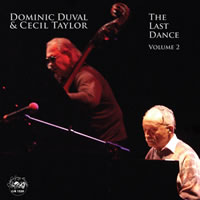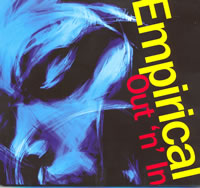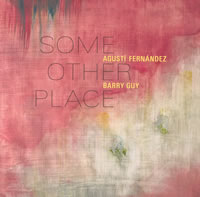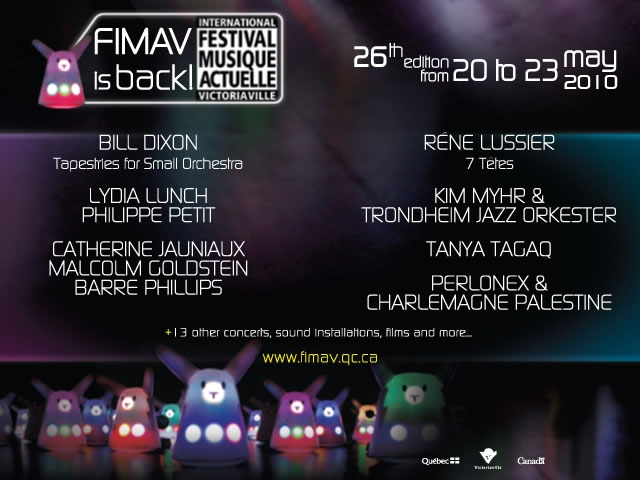Moment's Notice
Reviews of Recent Recordings
(continued)
Dave Douglas' Tiny Bell Trio
Constellations
hatOLOGY 666
 Now on its third printing, Dave Douglas' classic Tiny Bell Trio release, Constellations, is a persuasive reminder of the singular artistry he demonstrated in the mid-1990s. Though his current discography continues to be far more stylistically diverse and conceptually open-minded than most of his generation's output, it was the seminal efforts of his (now defunct) string ensemble and Tiny Bell Trio that were his most distinctive, and among the most unique and impressive documents of the mid-nineties jazz scene.
Now on its third printing, Dave Douglas' classic Tiny Bell Trio release, Constellations, is a persuasive reminder of the singular artistry he demonstrated in the mid-1990s. Though his current discography continues to be far more stylistically diverse and conceptually open-minded than most of his generation's output, it was the seminal efforts of his (now defunct) string ensemble and Tiny Bell Trio that were his most distinctive, and among the most unique and impressive documents of the mid-nineties jazz scene.
Douglas founded the Tiny Bell Trio concurrently with John Zorn's Radical Jewish Culture Festival in the early nineties, describing the unit as a "jazz-Balkan improv" group. But where Zorn's original Masada Quartet (which featured Douglas) was focused on updating Hassidic and Yiddish traditions, Douglas' trio with guitarist Brad Shepik and drummer Jim Black was more far-ranging. On Constellations, their second album, they embraced a seemingly endless range of material, re-working everything from Robert Schumann's playful "Vanitus Vanitum" to an ebullient take on Herbie Nichols' "The Gig."
Recorded mid-tour in 1995, Douglas' compositional voice is in full bloom, conferring a dynamic blend of petulant humor and grave seriousness to the trio's seasoned interplay. Energized by their concurrent live gigs, Eastern European-inspired fare like the title track, "Unhooking the Safety Net" and "Hope Ring True" burst at the seams with vacillating gypsy rhythms, start-stop tempos and soaring folk melodies, while dramatic ruminations like "Taking Sides" and "Maquiladora" invoke socio-political concerns. Inspired by that decade's Balkan conflict, "Taking Sides" erupts in a frantic patchwork of pneumatic downbeats, clarion horn cadences and kaleidoscopic fretwork. Similarly topical, "Maquiladora" is an epic meditation on the nature of perseverance, named after the American-run factories along the Mexican-American border, infamous for low pay and dangerous working conditions. Douglas and company weave a note of optimism into the tune's melancholy theme, which encapsulates a range of emotions, from sorrow to indignation, culminating in a poignant coda.
The trio's self-titled debut for Songlines from the previous year was a solid first effort, and their 1999 swan-song, Songs For Wandering Souls (Winter & Winter) contained moments of blissful inspiration, but neither of those studio sessions conveyed the unflagging energy and singular vision of this date. For the past few years, Douglas has focused on exploring the pre-fusion advancements of Miles Davis' second great quintet with his own electro-acoustic quintet and Keystone project. These ensembles are responsible for a fair share of compelling music, but neither line-up has released a session as richly multi-layered and emotionally resonant as this unique record. One of the finest albums of the 1990s, Constellations is easily Douglas' crowning achievement.
-Troy Collins
Dominic Duval + Cecil Taylor
The Last Dance, Volumes 1 + 2
Cadence Jazz Records CJR 1229/30

 This double CD presents the full Taylor-Duval duet performance at the 2003 San Francisco Jazz Festival, a few minutes of which is seen in Chris Felver’s Taylor documentary, All the Notes. And really, hearing a full performance – in all its grandeur or with all its flaws – is the only proper way to appreciate just how singular an artist Cecil Taylor is. The overwhelming speed and density that once made his playing so intense and confrontational is less in evidence; the tempos during the 90-minute performance are medium to slow for the most part and there’s plenty of space. But the expressive power of Taylor’s playing remains undiminished. He can still summon awe-inspiring moments through both the sheer force of his playing and its extraordinary subtlety. As for flaws, well, with Taylor there are almost always moments when the music is casting about in search of a direction. Taylor asks listeners to accept those moments as a necessary part of the music-making process. If one is willing to stay with the music, the pay-off is almost always worth the wait. That is certainly the case here.
This double CD presents the full Taylor-Duval duet performance at the 2003 San Francisco Jazz Festival, a few minutes of which is seen in Chris Felver’s Taylor documentary, All the Notes. And really, hearing a full performance – in all its grandeur or with all its flaws – is the only proper way to appreciate just how singular an artist Cecil Taylor is. The overwhelming speed and density that once made his playing so intense and confrontational is less in evidence; the tempos during the 90-minute performance are medium to slow for the most part and there’s plenty of space. But the expressive power of Taylor’s playing remains undiminished. He can still summon awe-inspiring moments through both the sheer force of his playing and its extraordinary subtlety. As for flaws, well, with Taylor there are almost always moments when the music is casting about in search of a direction. Taylor asks listeners to accept those moments as a necessary part of the music-making process. If one is willing to stay with the music, the pay-off is almost always worth the wait. That is certainly the case here.
No pianist has as many ways to touch a piano as Taylor, every nerve twitch in his fingers seems directly wired into an expressive intent. A fortissimo cluster of notes can hit as hard as a blacksmith hammer, only to be followed by a pianissimo caress. The abrupt contrasts are so extreme that they still have the power to startle. He’s also paying closer attention to the decay of his notes than in other recordings, letting tones linger and the colors slowly fade. At times it’s a melancholy effect and the music often has a tragic grace. He usually approaches lyrical moments mistrustfully, retreating into further dissonant storming against the metaphysical gates. But here, more frequent blossomings of beauty linger longer than in the past before a gust of notes blows them away. The 67-minute first set gives way about two-thirds of the way in to Taylor’s vocalizing and poetry, first accompanied by Duval, then with piano added. The collage of voice, words, sounds, and silence provides an interlude of relative peace before the instrumental climax.
Duval, who was nearing the end of his decade-long tenure with the pianist in 2003, is finely attuned to Taylor’s mercurial ways. The additional space in the music gives him places to fill in, to add embellishments and commentary. He’s confident enough to play independently, alert enough to get in synch. His malleable tone, hard and metallic at times, dark and yielding at others, adds to Taylor’s own explorations of textures and timbres. Duval also is a canny rhythmic accompanist for Taylor, a dance partner who can parallel or contrast with what Taylor is doing. And there is a real sense of give and take between Duval and Taylor, which Taylor’s devil-take-the-hindmost energy level used to obscure in days past. More often that not, Taylor is piloting the improvisation in the direction he wants, but Duval is a willing passenger and not altogether subservient, either. Their chemistry is one of this album’s many pleasures.
–Ed Hazell
Empirical
Out 'n' In
Naim Jazz Naimcd139
 The young British quartet Empirical dedicates their sophomore effort, Out 'n' In to the memory of visionary multi-instrumentalist Eric Dolphy. Featuring six original tunes, three brief improvised interludes and two covers drawn from Dolphy's 1964 Blue Note masterpiece, Out To Lunch ("Hat & Beard" and "Gazzelloni"), the quartet embarks on a program reminiscent of the Blue Note label's more adventurous releases of the mid-1960s.
The young British quartet Empirical dedicates their sophomore effort, Out 'n' In to the memory of visionary multi-instrumentalist Eric Dolphy. Featuring six original tunes, three brief improvised interludes and two covers drawn from Dolphy's 1964 Blue Note masterpiece, Out To Lunch ("Hat & Beard" and "Gazzelloni"), the quartet embarks on a program reminiscent of the Blue Note label's more adventurous releases of the mid-1960s.
Their self-titled debut, produced by saxophonist Courtney Pine for his Destin-E imprint in 2007, was widely revered in the British press. Since then, the band has undergone a series of drastic personnel changes, with only alto saxophonist Nathaniel Facey and drummer Shaney Forbes remaining from the original line-up. Trumpeter Jay Phelps has left, bassist Neil Charles has been replaced by Tom Falmer, and vibraphonist Lewis Wright occupies the void left by departing pianist Kit Downes. Julian Siegel makes a guest appearance on this date, augmenting the quartet with bass clarinet and tenor saxophone, restoring the band to a five piece.
The group's interpretations of the Dolphy covers are enthusiastic and respectful, with the careening, alto-driven "Gazzelloni" especially notable, but their original tunes, written in a similarly angular style, convey a greater spark of personal ingenuity. Inspired by Dolphy's "Mrs. Parker of KC," the hard-charging boppish opener "Out But In" pays tribute to the blues, bop and Dolphy's own interpretation of the same, blending ensemble freedom with traditional forms, highlighted by Facey's tortuous alto, Wright's effervescent vibes and Falmer's pliant bass. The dovetailing, circuitous interplay between Facey and Siegel on the short improvised interlude "A Conversation" brims with vigor and melodic invention, while tracks like "So He Left" (alluding to Dolphy's rotating membership in Charles Mingus' volatile bands) shift effortlessly through modulating tempos.
Demonstrating their compositional acumen, the ten minute epic "Dolphyus Morphyus" is a through-composed tribute to Dolphy's ability to "tell stories" with his narrative style of soloing, rather than hemming to conventional chord changes. As thematic motifs are passed between bass clarinet, vibraphone and alto, Falmer and Forbes offer superlative support through a challenging series of changes in mood and rhythm. Highlighting the rich interplay between Facy's acerbic alto and Siegel's muscular tenor, "Syndicalism" ranges further a field with a climactic collective improvisation that balances impetuous fervor with kaleidoscopic detail. The mournful ballad "A Bitter End For a Tender Giant" and the dulcet "Bowden Out" reveal their reflective side, spotlighting an introspective sound influenced by Dolphy's colorful aesthetic.
Out 'n' In is an enjoyable excursion into the fertile no-man's-land between inside and outside traditions. Much like the current endeavors of Chicago-based artists like Jason Adasiewicz and Josh Abrams, Empirical plumbs a winning mid-1960s Blue Note formula, casting fresh light on a revered legacy while subtly updating it. The young members of the quartet have some ways to go before attaining an identifiable sound, but if this session is any indication, there are clearly great things to come.
-Troy Collins
Augusti Fernández + Barry Guy
Some Other Place
MCD 0802
 From the first notes, seasoned listeners of the music of Barry Guy and Agusti Fernández will understand that Sun Ra-esque title indicates territories not necessary associated with European Free Improvisation, even if both men have amply demonstrated their capacity to explore a word of nuances and evoke both the spirit of jazz past and the vitality of traditional musics from the world. This series of duets are not necessarily free improvisations; but use a mixture of precomposed material and open form, a technique that Barry Guy pioneered in his groundbreaking orchestra works. This allows the pieces to go back to fixed materials and specific passages, giving the music a special sharpness, a directness that does not deter from the freedom the musicians allowed to themselves. Guy and Fernández have been collaborating in different ensembles for about ten years now, and their musical conception is well-matched. The bassist is known for his mastery of the whole range of his instrument, from which he elicits unprecedented sounds, bringing it up to the violin range or phrasing like a guitar player, even if in this particular CD I have the impression that he plays less bow than usual. The pianist seamlessly integrates extended techniques in his playing, and can stimulate the strings via keyboard to produce classically styled, smooth sounds or attack them into percussive frenzy.
From the first notes, seasoned listeners of the music of Barry Guy and Agusti Fernández will understand that Sun Ra-esque title indicates territories not necessary associated with European Free Improvisation, even if both men have amply demonstrated their capacity to explore a word of nuances and evoke both the spirit of jazz past and the vitality of traditional musics from the world. This series of duets are not necessarily free improvisations; but use a mixture of precomposed material and open form, a technique that Barry Guy pioneered in his groundbreaking orchestra works. This allows the pieces to go back to fixed materials and specific passages, giving the music a special sharpness, a directness that does not deter from the freedom the musicians allowed to themselves. Guy and Fernández have been collaborating in different ensembles for about ten years now, and their musical conception is well-matched. The bassist is known for his mastery of the whole range of his instrument, from which he elicits unprecedented sounds, bringing it up to the violin range or phrasing like a guitar player, even if in this particular CD I have the impression that he plays less bow than usual. The pianist seamlessly integrates extended techniques in his playing, and can stimulate the strings via keyboard to produce classically styled, smooth sounds or attack them into percussive frenzy.
This is one of those recordings that draws listeners close and keeps their attention focused. Their exchanges are so quick and so rich that, at slightly less than hour, the CD has the perfect duration of a concert set, and none of the pieces overstays its welcome, the longest being “Dark Energy” at less then nine minutes. Guy and Fernández bask into the sound and resonances of their instruments, and let the listener join in, be it the slightly Monkian distillation of “How To Go Into A Room If You're Already In” or the telluric vibrations of “Rosette” and “Crab Nebula”: attention to detail does not necessarily mean excessive caution, and several tracks feature all-out explorations, making the contrast with the more restrained pieces more effective.
“Blueshift”, an elegiac piece dedicated by Guy to his musician wife Maya Homburger, is certainly one of the high points of the album. We hear them state the theme with the piano improvising around it, and then the roles are reversed, with an intense, intimate dialogue of bulding tension: arguably the finest realization of what Bill Evans and Scott LaFaro were working on. The sound is glorious. Listen to the clarity of Guy's altissimo register, and then to the perfectly pitched fat low notes of the bass expanding in space like drops of ink in water. I am adding this track to the short playlist that I use for the uninitiated asking me for a compilation of this weird music I listen to. If you don't find anything to like here, maybe this area of music is not for you and you should pick up stamp collecting or something. By any standard a great record.
–Francesco Martinelli
Grosse Abfahrt
Vanity
Emanem 5007
 Trumpeter Tom Djll assembled the Grosse Abfahrt project a few years ago to explore certain issues in the dynamics of improvised music. Each performance involves eight to ten players, a fairly large ensemble in the terms of improvised music and one which allows for both individuals to emerge from the ensemble and for the entire ensemble to “cohere into long-form structures that transcend the productions of conventional improvised-music sociality.” I take that to mean the kinds of habitual sub-groupings and shared approaches that often dull improvised music, and which are less likely amongst eight players than four or five. Another key element in each meeting of the group is the presence of guest musicians who hail fairly far from the group’s Bay-area base. The group includes five musicians who function as constants. In addition to Djll, these are clarinettist Matt Ingalls, guitarist John Shiurba, Tim Perkis on electronics and Gino Robair on “energized surfaces and voltage made audible,” which seems to mean amplified percussion and electronics. Each performance, then, involves both a core of musicians who are familiar with one another’s processes and musicians who are new to them (but who may well be familiar with each other). Here the guests are French musicians Matthieu Werchowski on violin and viola and David Chiesa on bass, with a third “local” guest, cellist Theresa Wong acting as a kind of bridge between the regular members and the string-playing guests. On the group’s previous CD Everything That Disappears, the European guests were Lê Quan Ninh and Frédèric Blondy, making the Grosse Abfahrt project a significant meeting ground between French and American improvisers.
Trumpeter Tom Djll assembled the Grosse Abfahrt project a few years ago to explore certain issues in the dynamics of improvised music. Each performance involves eight to ten players, a fairly large ensemble in the terms of improvised music and one which allows for both individuals to emerge from the ensemble and for the entire ensemble to “cohere into long-form structures that transcend the productions of conventional improvised-music sociality.” I take that to mean the kinds of habitual sub-groupings and shared approaches that often dull improvised music, and which are less likely amongst eight players than four or five. Another key element in each meeting of the group is the presence of guest musicians who hail fairly far from the group’s Bay-area base. The group includes five musicians who function as constants. In addition to Djll, these are clarinettist Matt Ingalls, guitarist John Shiurba, Tim Perkis on electronics and Gino Robair on “energized surfaces and voltage made audible,” which seems to mean amplified percussion and electronics. Each performance, then, involves both a core of musicians who are familiar with one another’s processes and musicians who are new to them (but who may well be familiar with each other). Here the guests are French musicians Matthieu Werchowski on violin and viola and David Chiesa on bass, with a third “local” guest, cellist Theresa Wong acting as a kind of bridge between the regular members and the string-playing guests. On the group’s previous CD Everything That Disappears, the European guests were Lê Quan Ninh and Frédèric Blondy, making the Grosse Abfahrt project a significant meeting ground between French and American improvisers.
The value of Djll’s reflections on group structure and interaction are apparent everywhere in the music. The special talents of Werchowski and Chiesa are apparent in an excerpt from an opening duo performance called “Hang Bat5 Over,” a performance of such resonant and meditative depth that it suggests some pieces by Arvo Pärt. Combining the strings with Wong and Shiurba gives a certain string dominance to the ensemble, and these sounds combine with the winds and electronics to emphasize sustained tones and rich, varied textures. Many of the full ensemble tracks are very brief. The opening “Sportsman’s Paradise Music LA” is less than a minute long and contrasts Webern-like evanescence with Chiesa’s contrarian pedal tone. “Cthulu Kids First” (Yes, the titles are weird: they’re taken from vanity plates and often add state mottos to the personal messages) just a little longer and highly abrasive. As bracing as the miniatures are, though, it’s the more expansive improvisations that leave the strongest impression, like the sustained silence that develops between constant high and low pitches on “Kablamo,” a silence developed not by the absence of sound but by a missing frequency range, or the dialogue between string harmonics and electronics in “CA Mirrors.” Throughout this is improvised music of the very first order, and Djll’s visual artwork, color photos of old cars and vanity plates, is as obliquely engaging as the music.
–Stuart Broomer
